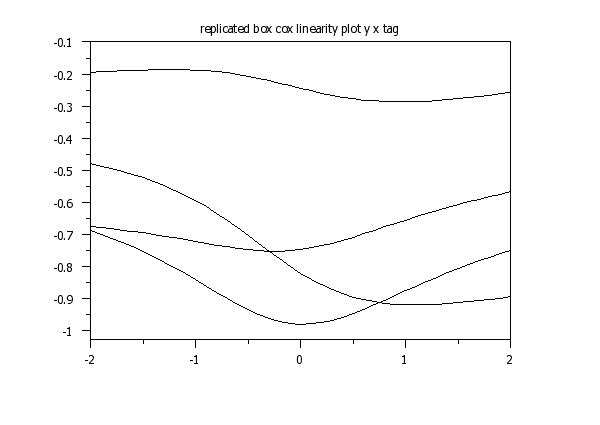

|
BOX COX LINEARITY PLOTName:
is essentially the power-transformation family (adjusted to include log transformations). The horizontal axis is the lambda parameter. The vertical axis is the computed correlation coefficient between <y> and the transformed <x> The lambda corresponding to the highest correlation is the appropriate transformation to use in linearizing the relationship between <y> and <x>
<SUBSET/EXCEPT/FOR qualification> where <y> is the first response variable; <x> is the second response variable; and where the <SUBSET/EXCEPT/FOR qualification> is optional.
<SUBSET/EXCEPT/FOR qualification> where <y> is the first response variable; <x> is the second response variable; <tag1> is a group-id variable; and where the <SUBSET/EXCEPT/FOR qualification> is optional. A Box-Cox linearity plot will be generated for each distinct value of the group-id variable. These plots will be overlaid on the same plot.
<SUBSET/EXCEPT/FOR qualification> where <y> is the first response variable; <x> is the second response variable; <tag1> is a group-id variable; <tag2> is a group-id variable; and where the <SUBSET/EXCEPT/FOR qualification> is optional. The two group-id variables are cross-tabulated and a Box-Cox linearity plot will be generated for each distinct combination of values for the group-id variables. These plots will be overlaid on the same plot.
REPLICATED BOX-COX LINEARITY PLOT Y X TAG
NIST/SEMATECH e-Handbook of Statistical Methods, Box-Cox Linearity Plot, 6/2003. NIST/SEMATECH e-Handbook of Statistical Methods, Box-Cox Linearity Plot Used in a Case Study, 6/2003.
2010/5: Support for REPLICATION option
SKIP 25
READ BERGER1.DAT Y X
LABEL CASE ASIS
Y1LABEL Correlation
X1LABEL Lambda
BOX COX LINEARITY PLOT Y X
 Program 2:
Program 2:
title case asis
title offset 2
title automatic
label case asis
multiplot corner coordinates 0 0 100 95
tic mark offset units screen
y1tic mark offset 2 0
.
reset data
skip 25
read nelson.dat y x tag
.
replicated box cox linearity plot y x tag

Date created: 11/30/2010 |
Last updated: 12/04/2023 Please email comments on this WWW page to [email protected]. | ||||||||||||||